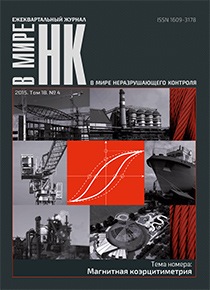Introduction. Complexity of welded joints nondestructive testing under operation conditions is associated with the heterogeneity of the metal structure within the heat-affected zone, which is a stress concentrator; the metal structure in this zone is being changed under cyclic loads. The work aim was to investigate the possibility of applying a coercimetry method to diagnostics of welds working under cyclic loads. Method. At low-cycle fatigue irreversible damage accumulation takes place even in a defect-free weld. The magnetic structurescope KRM-Ts-K2M was used for detection of this damage by the value of the coercive force increase. The impact of load parameters on a coercive force was studied on the basis of static and cyclic testing of samples with butt and fillet (T-shaped) welds. Results. Numerous static and cyclic testing of welds and base metal have enabled the author to determine correlation between a coercive force value and weld resource parameters for the conventional steel grades St3sp, 09G2S and 10KhSND. Prospects of small (with the base ≤ 20 mm) sensors application for weld local diagnostics has also been shown in the work. Conclusion. Combination of magnetic structural testing by a coercive force method with an ultrasonic inspection makes it possible to predict a physical resource of metal work at the examination of hazardous production facilities.
magnetic structural testing, coercive force, steel, welds, static and cyclic load, resource evaluation
1. Popov B. E., Kotel´nikov V. S., Levin E. A. Bezopasnost´ truda v promyshlennosti [Industrial operation safety]. 2001, no. 2, pp. 44-49 (in Russ.).
2. Kotel´nikov V. S., Popov B. E., Bezlyud´ko G. Ya., and Levin E. A. Sb. trudov NPK «Problemy proizvodstva i bezopasnoy ekspluatatsii pod´emnykh sooruzheniy v Ukraine i Rossii» [Proc. of NPK “Problems of Manufacturing and Safe Operation of Hoisting Equipment in Ukraine and Russia”]. 2002, pp. 232-245 (in Russ.).
3. Popov B. E., Bezlyud´ko G. Ya., Elkina E. I., and Solomakha R. N. V mire NK [NDT World]. 2009, no. 2(44), pp. 28-32 (in Russ.).
4. Prokhorov A. V. Magnitnyy kontrol´ (po koertsitivnoy sile) urovnya nakoplennykh ustalostnykh povrezhdeniy pri tsiklicheskikh nagruzkakh v svarnykh soedineniyakh staley 09G2S i VSt3sp5 [Magnetic testing (by a coercive force) of accumulated fatigue damage level under cyclic loads in welded joints of steels 09G2S and VSt3sp5]. (Ufa State Petroleum Technological University). Available at: http://www.ogbus.ru/authors/Prokhorov/prokh1.pdf (in Russ., accessed 19.11.2015).
5. Vonsovskiy S. V. Magnetizm [Magnetics]. Moscow, Nauka, 1971. 1032 p. (in Russ.).
6. Mikheev M. N., Gorkunov E. S. Magnitnye metody strukturnogo analiza i nerazrushayushchego kontrolya [Magnetic methods of structural analysis and nondestructive testing]. Moscow, Nauka, 1993. 252 p. (in Russ.).
7. Shcherbinin V. E., Gorkunov E. S. Magnitnyy kontrol´ kachestva metallov [Magnetic inspection of metals quality]. Ekaterinburg, URO RAN, 1996. 264 p.
8. Bida G. V., Gorkunov E. S., Shevnin V. M. Magnitnyy kontrol´ mekhanicheskikh svoystv prokata [Magnetic inspection of rolled stock mechanical properties]. Ekaterinburg, UrO RAN, 2002. 252 p.
9. Sandomirskiy S. G. Raschet i analiz razmagnichivayushchego faktora ferromagnitnykh tel [Calculation and analysis of demagnetizing factor of ferromagnetic bodies]. Minsk, Belorusskaya nauka, 2015. 243 p.
10. Ivanova V. S., Terent´ev V. F. Priroda ustalosti metallov [The nature of metal fatigue]. Moscow, Metallurgiya, 1975. 455 p.
11. RD IKTs «Kran» 007-97-02. Magnitnyy kontrol´ napryazhenno-deformirovannogo sostoyaniya i ostatochnogo resursa pod´emnykh sooruzheniy pri provedenii ikh obsledovaniya i tekhnicheskom diagnostirovanii (ekspertize promyshlennoy bezopasnosti) [Magnetic inspection of hoisting equipment stress-strain state and residual life at its examination and technical diagnosis (expert examination of industrial safety)], approved by Rostekhnadzor 14.04.2004, no. 12-07/360.





